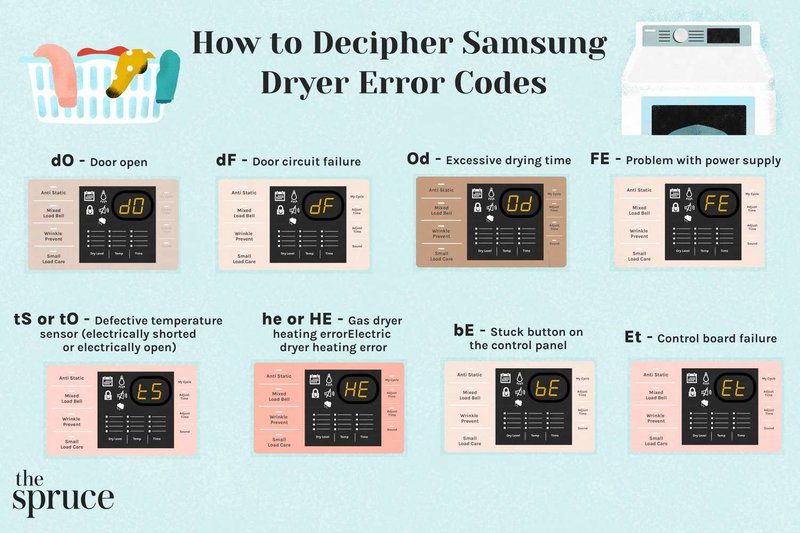
You might be wondering, “Why is understanding this error code important?” Well, knowing why your dryer is acting up can save you from unnecessary stress and costly repairs. It empowers you with the knowledge to troubleshoot basic issues, allowing for smoother laundry cycles. You see, sometimes it’s the simplest things, like a blocked vent or a faulty sensor, that can disrupt your laundry routine. By understanding these underlying causes, you can take quick action to address them and keep your home running smoothly.
Understanding the E1 Error Code
Here’s the deal: the E1 error code on a Samsung dryer is a signal that there might be an issue with the venting system or the dryer’s internal temperature management. Now, think of the vent as the dryer’s exhaust pipe. Just like your car needs a clear exhaust to run efficiently, your dryer needs its vent clear to function properly. When the vent is blocked or partially obstructed, hot air cannot escape. This leads the dryer to overheat and flash that dreaded E1 code as a warning sign.
Another important aspect of this error code is the temperature sensor. Inside your dryer, there are several components working together to ensure your clothes dry efficiently. The temperature sensor, also known as a thermistor, plays a crucial role. It monitors the dryer’s internal temperature and communicates with the control board to maintain optimal drying conditions. If this tiny but mighty component fails or gives incorrect readings, it can trigger the E1 error.
So, what are the consequences if you ignore this code? Operating your dryer with a persistent E1 error can lead to bigger problems. The dryer could become inefficient, using more energy than necessary, or even pose a fire risk due to overheating. It’s crucial to address the error as soon as it appears to keep both your appliance and your home safe.
Common Causes Behind the E1 Error
A typical cause of the E1 error code is a blocked vent. Over time, lint, dust, and debris can accumulate in the dryer’s vent system, much like leaves and dirt clogging your home’s gutters. This blockage restricts airflow, causing the dryer to overheat and display the E1 code. Regularly cleaning the vent, ideally every few months, can prevent this issue and promote efficient dryer performance.
Next in line is a faulty temperature sensor. Picture this: the sensor is like a thermostat for your dryer. If it malfunctions, it can mistakenly report incorrect temperatures, causing the dryer to react unnecessarily. This can happen due to normal wear and tear or an electrical fault. Replacing or recalibrating the sensor is often necessary to resolve this issue and restore your dryer to its optimal functionality.
Another possible culprit is a defective control board. Consider the control board as the dryer’s brain, processing inputs from various components, including the temperature sensor. If the board malfunctions, it might not interpret data correctly, leading to unnecessary error codes like E1. While this is less common, if you’ve exhausted other possibilities, consulting a professional for a control board examination might be the next best step.
Steps to Troubleshoot and Fix the E1 Error
So, you’ve determined that your Samsung dryer is displaying an E1 error code. What next? First, ensure your dryer vent is clear. Disconnect the dryer, carefully pull it away from the wall, and inspect the vent for any blockages. Using a vacuum or a designated dryer vent cleaning tool, remove any lint or debris. Once cleaned, check if the error persists after running the dryer.
If the vent isn’t the issue, you might have to inspect the temperature sensor. This step might be a bit technical for beginners, so it’s important to follow the dryer manual carefully. If you’re unsure, contacting a professional technician can save time and prevent further damage.
Finally, if all else fails, the problem might lie within the control board. While replacing or repairing this component is typically best left to professionals, understanding that this could be a potential issue empowers you to seek the appropriate help without unnecessary guesswork.
Prevention Tips to Avoid Future Errors
Prevention is always better than repair. To keep that E1 error at bay, make regular maintenance part of your laundry routine. Ensure that you’re cleaning the lint filter after each load. This simple task prevents lint from building up and migrating into the vent system.
Perform a thorough vent cleaning every few months. By keeping the paths clear, you allow the dryer to function efficiently and safely. Additionally, consider investing in a dryer vent alarm, which alerts you if airflow becomes restricted, preventing potential issues before they escalate.
Lastly, schedule a professional inspection annually. A technician can check all parts of your dryer, including the vent, sensor, and control board, ensuring everything is in top working order. This proactive approach saves you time, stress, and money in the long run.
In conclusion, while an E1 error code can be frustrating, understanding its common causes and how to address them can transform what seems like a daunting problem into a manageable task. By maintaining your dryer and staying vigilant to changes, you’ll keep your appliance running smoothly and extend its lifespan.